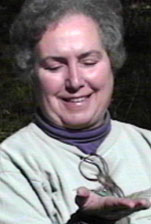 |
Nancy L. Newfield has been watching hummingbirds at her Louisiana home and lots of other places since 1975. Nancy lost her amateur status years ago, and now writes and lectures on hummers. She is co-author of Hummingbird Gardens, reviewed elsewhere on this site. Nancy is also a licensed hummingbird bander and a recognized authority on hummingbird distribution, behavior, and taxonomy. |
December 1997
Trading Places
How many times have you heard people say, "I know it is the same bird because it always perches in the same spot." Maybe. Maybe not.
Being able to watching banded and color-marked hummingbirds has given me a unique perspective. Yes, hummers do return to the same perches day after day. And year after year, they return to the same territories. But, not always.
The hummers that winter in my yard are especially interesting. A couple of years ago, an immature male Rufous Hummingbird staked out a claim to a coral honeysuckle vine across the driveway from my office window. I could watch him all day, every day.
This bird was more aggressive and belligerent than any of the other hummers. "Bad Dog," I nicknamed him. From his perch (actually, he had three favorite perches) he had a good view of five feeders and he defended all of them vigorously.
Immature Rufous have an amazing array of plumages. This one had part of his gorget filled in on the right side, but his back was completely green. He stood out from several other immature male Rufous, which had differing patterns of rust-colored patches on their backs. But after banding, "Bad Dog" got a spot of bright pink paint to make him even more distinctive.
I watched "Bad Dog" chase other hummers from his domain. Sometimes the fierceness of his attacks drove other hummers to the ground.
One day I was watching a grand chase and noticed that the aggressor was unmarked. He looked just like "Bad Dog," partial gorget on the right side and all, but this was not the same surly hummer I'd been keeping my eye on. "Bad Dog" had been replaced.
Soon, I captured and marked the newcomer. "Killer," I dubbed the now yellow-marked Rufous, whose temper matched the fiery color of his gorget.
Meanwhile, "Bad Dog" had taken up a new territory in the back of the yard. Chastened, his demeanor was more subdued than it had been when he ruled the prime territory with five feeders.
"Killer" picked up where "Bad Dog" left off, keeping all other hummers at bay. The yard was like a combat zone.
Three weeks passed. Then, "Killer" was displaced by yet another immature male with similar plumage and an irascible disposition. The new bird "Grumpy" soon got a spot of white paint to distinguish him from his two devilish brethren. Meanwhile, "Killer" moved to the front yard and became a bit more docile - only a bit, though!
So, here were three different individuals that were similar in appearance and behavior. And, each used the same perch!!
Of course, sometimes hummers return to the same yard and choose different territories than they had held the previous season. One female Buff-bellied Hummingbird comes to mind. She has returned for four winters. Each season, she has held a different area of the yard and each season, she has displayed a different set of behaviors.
Trading places is a popular hummer game!
Happy Hummingbirding and Merry Christmas!!
Copyright © 1997
Nancy L. Newfield
Casa Colibri
Metairie, LA
Previous Hummer Notes columns: July 1996 | August 1996 | September 1996 | October 1996 | November 1996 | December 1996 | January 1997 | February 1997 | March 1997 | April 1997 | May 1997 | June 1997 | July 1997 | August 1997 | September 1997 | October 1997 | November 1997